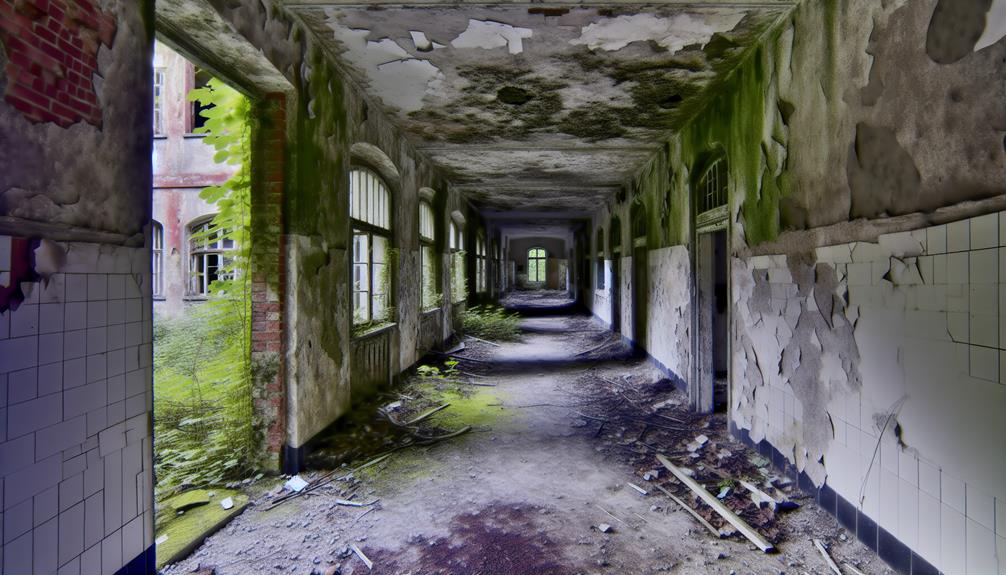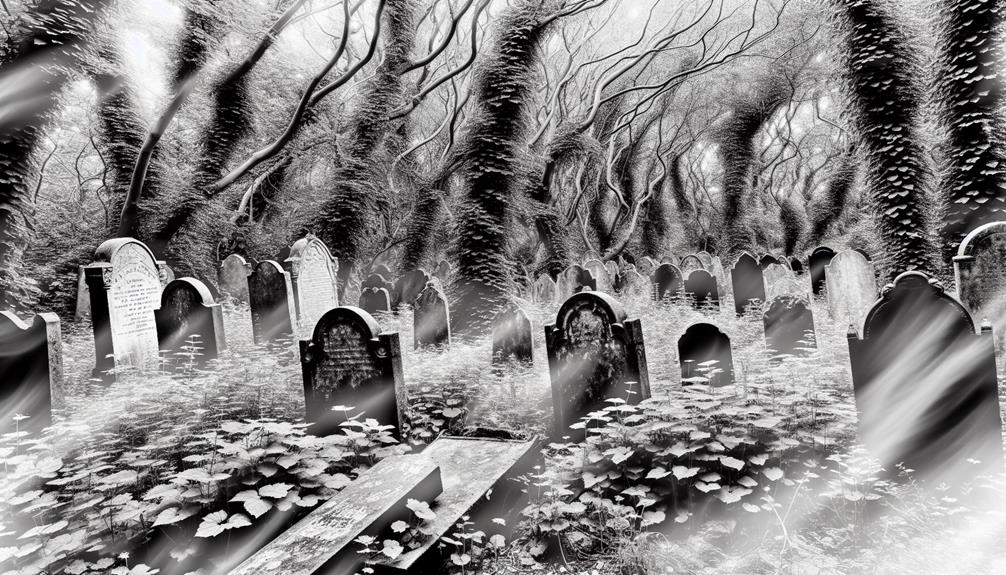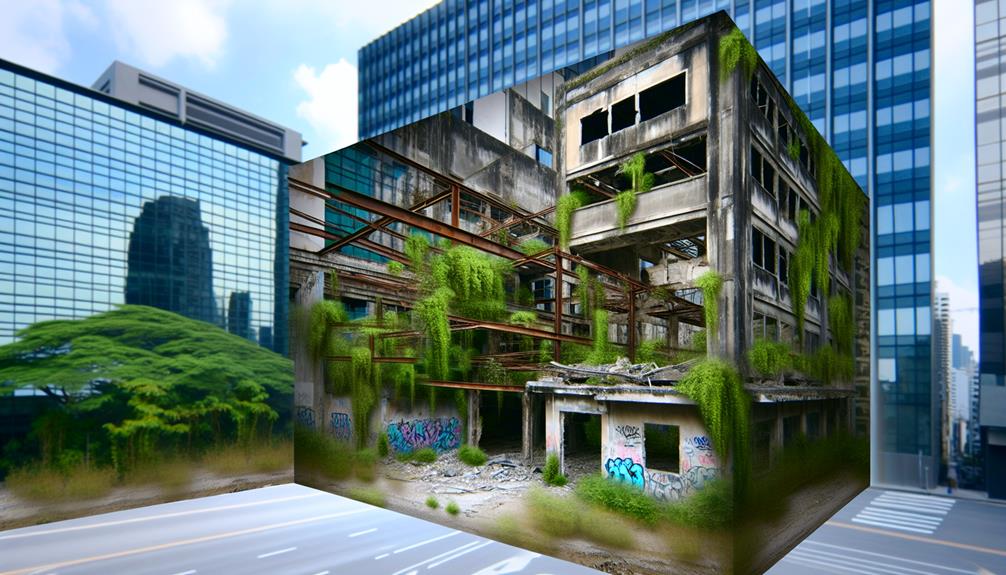Nestled in the heart of Germany, Beelitz-Heilstätten stands as a testament to a bygone era of medical history and architectural grandeur. Once a symbol of healing, this sprawling complex witnessed the footsteps of notable figures seeking treatment within its walls. However, as time cast its shadow over the site, whispers of abandonment and decay now echo through its corridors. Yet, amidst the peeling paint and crumbling facades lies a tale of resilience and restoration, beckoning curious minds to uncover the secrets that lie within.
Key Takeaways
- Historic sanatorium converted into military hospital.
- Mix of historical and modern architecture.
- Famous patients like Hitler and Einstein.
- Abandoned, decaying, but hauntingly beautiful.
- Ongoing restoration and sustainable development efforts.
History of Beelitz-Heilstätten
The history of Beelitz-Heilstätten, located in Germany, encompasses a rich tapestry of medical advancements, societal changes, and architectural developments that have left an indelible mark on the landscape of healthcare and historical preservation.
One of the most significant aspects of Beelitz-Heilstätten is its role in medical breakthroughs. Originally established as a sanatorium for tuberculosis patients in the late 19th century, Beelitz-Heilstätten played a pivotal role in pioneering treatments for this infectious disease. The site's medical facilities were at the forefront of innovative therapies and research, contributing to advancements in healthcare practices that have had a lasting impact on modern medicine.
Moreover, Beelitz-Heilstätten holds immense cultural significance. Over the years, the site evolved from a tuberculosis sanatorium to a military hospital during World War I and World War II, witnessing the transformative effects of historical events on its premises. The diverse functions that Beelitz-Heilstätten has served reflect the changing societal needs and values throughout different periods. This cultural evolution has turned Beelitz-Heilstätten into a symbol of resilience and adaptation, highlighting the site's ability to endure and thrive amidst shifting circumstances.
The layered history of Beelitz-Heilstätten not only sheds light on past medical practices but also offers a glimpse into the broader socio-cultural landscape of Germany and its healthcare system.
Architecture and Design
Architecture and design at Beelitz-Heilstätten showcase a blend of historical influences, functional considerations, and innovative construction techniques that have shaped the site's physical character and contributed to its significance in the field of healthcare architecture. The buildings at Beelitz-Heilstätten reflect a mix of architectural styles, with elements ranging from the traditional red-brick facades of the early 20th century to more modern influences seen in later additions.
Throughout its history, Beelitz-Heilstätten has undergone renovations and expansions that have integrated sustainable practices into its design. The incorporation of sustainable materials, energy-efficient systems, and thoughtful landscaping not only enhances the site's environmental credentials but also secures its continued relevance in a world increasingly focused on eco-friendly solutions.
The layout and design of Beelitz-Heilstätten prioritize functionality and patient well-being. The buildings are organized to maximize natural light and ventilation, creating a healing environment that aligns with modern healthcare standards. Interior spaces are thoughtfully designed to promote a sense of calm and comfort, with an emphasis on privacy and tranquility for patients.
Innovative construction techniques have been employed to preserve the historical integrity of the site while adapting it to meet contemporary healthcare needs. The careful balance of preserving the past while embracing the future is evident in the architecture and design choices at Beelitz-Heilstätten, making it a unique and enduring example of healthcare architecture that continues to inspire and captivate visitors from around the world.
Famous Patients and Visitors
Demonstrating the historical significance of Beelitz-Heilstätten, notable individuals from various fields have sought treatment or visited the renowned healthcare complex, adding layers of cultural and historical relevance to its storied past. Among the celebrity connections to Beelitz-Heilstätten is the infamous Nazi dictator Adolf Hitler, who was treated at the facility after sustaining injuries during World War I. This dark chapter in the complex's history serves as a stark reminder of its involvement in significant historical events.
In a more positive light, Beelitz-Heilstätten has also welcomed notable figures such as Albert Einstein, who visited the sanatorium during his time in Germany. The presence of such esteemed personalities underscores the reputation and appeal of Beelitz-Heilstätten as a center of medical excellence and innovation.
Moreover, the healthcare complex has attracted artists and writers seeking inspiration or respite, including renowned author Theodor Fontane. Their presence not only highlights the cultural significance of Beelitz-Heilstätten but also emphasizes its allure as a place of creative energy and intellectual stimulation.
Abandonment and Decay
Amidst its illustrious history and the notable individuals who once graced its halls, Beelitz-Heilstätten now stands as a haunting proof of abandonment and decay, with the passage of time revealing a stark contrast to its former glory. The once-majestic buildings that housed the sick and wounded are now shrouded in a cloak of neglect, their walls echoing with the whispers of a bygone era. Despite the challenges of exploring these decaying structures, many are drawn to the haunting beauty that lies within the crumbling walls.
—
| Exploration Challenges | Haunting Beauty | Impact of Decay |
|---|---|---|
| Safety hazards such as unstable structures and debris | Eerie atmosphere with peeling paint and broken windows | Loss of historical significance |
| Difficulty traversing dark corridors and collapsing floors | Nature reclaiming the buildings with overgrown vines | Structural integrity compromised |
| Risk of encountering wildlife or trespassers | Faded grandeur evoking a sense of nostalgia | Symbol of the passage of time |
| Limited access due to restricted areas and security measures | Silent halls resonating with the whispers of the past | Neglected heritage site |
| Emotional challenges of witnessing the effects of neglect | Beauty in decay, capturing the imagination of photographers | Reminder of the fragility of human creations |
—
Urban Exploration Opportunities
A myriad of urban exploration opportunities awaits those who seek to explore the depths of Beelitz-Heilstätten, offering a unique perspective on the intersection of history, architecture, and abandonment. Within the sprawling complex, numerous photography spots present themselves, allowing visitors to capture the haunting beauty of the decaying buildings and overgrown surroundings. The play of light filtering through shattered windows onto cracked walls creates a mesmerizing setting for both amateur and professional photographers alike.
Explorers can venture through the forgotten hallways and crumbling corridors, uncovering hidden passages that lead to long-forgotten rooms filled with remnants of the past. Each corner turned reveals a new story, a glimpse into the lives of those who once inhabited these now desolate spaces. The sense of mystery and intrigue that permeates the air adds a layer of excitement to the exploration, drawing visitors deeper into the heart of Beelitz-Heilstätten.
For those with a keen eye for detail, the intricate architectural elements that have stood the test of time provide a fascinating subject for study. From ornate moldings to faded frescoes, every inch of Beelitz-Heilstätten holds a piece of history waiting to be uncovered. As visitors navigate the labyrinthine layout of the complex, they are met with a sense of freedom, the opportunity to roam and discover at their own pace, making each exploration a truly unique experience.
Preservation Efforts and Future Plans
What strategies are being implemented to guarantee the preservation and future development of Beelitz-Heilstätten in Germany? Beelitz-Heilstätten faces significant preservation challenges due to its size and historical significance. To secure its conservation and sustainable future, the following steps are being taken:
- Historical Restoration: Efforts are underway to restore key historical buildings within Beelitz-Heilstätten to their former glory. This includes repairing damaged structures, preserving original architectural features, and ensuring historical accuracy in renovations.
- Sustainable Development: Future plans focus on balancing preservation with modern needs. Sustainable development practices are being incorporated to minimize environmental impact while allowing for necessary updates to infrastructure and facilities.
- Community Engagement: Recognizing the importance of community involvement, initiatives are being implemented to engage local residents, historians, and stakeholders in the preservation and development process. This includes hosting community workshops, seeking feedback on proposed plans, and fostering a sense of ownership among the community.
- Tourism Management: With the site's popularity for urban exploration, strategies for responsible tourism management are being devised. This involves creating guided tours, implementing visitor regulations to protect the site, and educating visitors on the historical significance of Beelitz-Heilstätten.
Through these preservation efforts and future plans, Beelitz-Heilstätten aims to safeguard its heritage while embracing sustainable development practices and fostering community involvement in shaping its future.
Frequently Asked Questions
Can Visitors Stay Overnight at Beelitz-Heilstätten?
Overnight accommodations vary at historical sites based on preservation goals and public safety measures. When considering tourist attractions like Beelitz-Heilstätten, accommodation options may be limited due to the site's historical significance and potential safety concerns.
Visitors should research available accommodations in the area to find suitable places to stay overnight. It is important to respect the site's regulations and understand the restrictions in place for overnight stays at such locations.
Are There Any Paranormal Activities Reported at the Site?
Reports of ghost sightings and supernatural experiences are common at historical sites worldwide. Paranormal investigations and haunted histories contribute to the allure of such locations.
For example, a renowned paranormal investigator documented unexplained noises and apparitions during a late-night investigation at a former hospital. These accounts fuel ongoing debates about the existence of spirits and the mysteries surrounding haunted places.
Is Beelitz-Heilstätten Haunted?
Ghostly encounters and supernatural phenomena are often subjects of fascination for many individuals. The existence of hauntings and paranormal activities at certain locations has been a topic of debate and intrigue.
Claims of spirits, unexplained happenings, and eerie encounters draw interest from those curious about the unknown. Investigations into alleged haunted sites aim to uncover the truth behind these mysterious occurrences, providing insight into the potential existence of entities beyond our understanding.
Are There Any Guided Tours Available at the Facility?
Guided tours provide an immersive experience, offering insights into the site's historical significance. Visitors can typically choose from various tour schedules to accommodate their preferences. Booking a tour is usually straightforward, with many facilities offering online booking options for convenience.
These tours are an excellent way for individuals to explore the facility in a structured manner, enhancing their understanding of its past and cultural relevance.
Can Visitors Access All Buildings at Beelitz-Heilstätten?
Accessibility to all buildings at the facility varies due to safety concerns and preservation efforts.
Exploring the historical significance of each structure can be a fascinating journey for visitors. While some buildings may be accessible with guided tours, others might be off-limits to guarantee the integrity of the site is maintained.
It is essential to respect any restrictions in place to safeguard the rich history and architectural heritage of the location.
Conclusion
To sum up, the history and architecture of Beelitz-Heilstätten in Germany showcase a unique blend of past medical practices and innovative design. Despite its current state of decay, efforts to preserve its historical significance and engage the community are underway.
The site serves as a reminder of the complexities of human history and the need for responsible management of cultural heritage. Its future relies on sustainable practices and continued efforts to maintain its iconic status.


